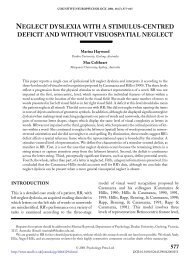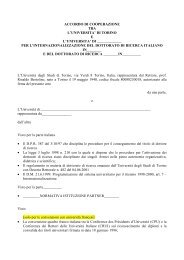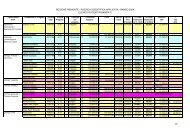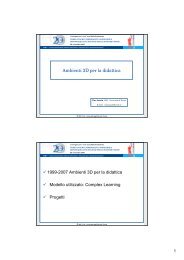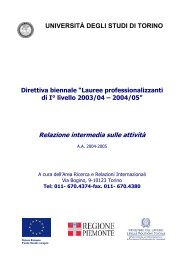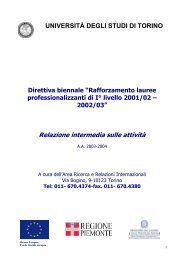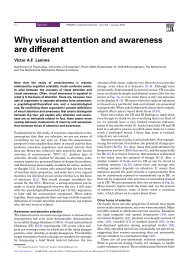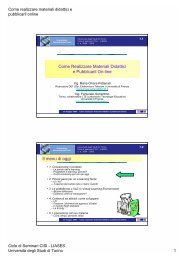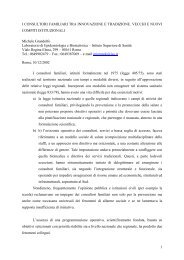Spatial hemineglect in humans - Cisi
Spatial hemineglect in humans - Cisi
Spatial hemineglect in humans - Cisi
Create successful ePaper yourself
Turn your PDF publications into a flip-book with our unique Google optimized e-Paper software.
G. Kerkho€ / Progress <strong>in</strong> Neurobiology 63 (2001) 1±27 21<br />
treatment studies (Diller and We<strong>in</strong>berg, 1977; We<strong>in</strong>berg<br />
et al., 1979). Later studies have implemented a<br />
similar approach and compared the tra<strong>in</strong><strong>in</strong>g of ecient<br />
scann<strong>in</strong>g <strong>in</strong> neglect patients with nonspeci®c cognitive<br />
tra<strong>in</strong><strong>in</strong>g (Antonucci et al., 1995) or comb<strong>in</strong>ed it with<br />
speci®c visuospatial tra<strong>in</strong><strong>in</strong>g (We<strong>in</strong>berg et al., 1979)<br />
patients. Cognitive tra<strong>in</strong><strong>in</strong>g has only m<strong>in</strong>or e€ects on<br />
neglect, while speci®c visuospatial tra<strong>in</strong><strong>in</strong>g ameliorates<br />
the associated spatial problems, but does not <strong>in</strong>¯uence<br />
visual scann<strong>in</strong>g. Table 6 summarizes evaluated treatment<br />
approaches as well as stimulation techniques<br />
with transient e€ects that might eventually become<br />
e€ective techniques of treatment.<br />
As <strong>in</strong> other areas of neurorehabilitation, pharmacological<br />
treatments have been suggested for di€erent<br />
types of disorders (Feeney and Hovda, 1985; Kertzman<br />
et al., 1990; McDowell, 1991; MuÈ ller and von<br />
Cramon, 1994; Huber et al., 1997). Treatment of<br />
neglect with dopam<strong>in</strong>agonists was prompted by the<br />
observation that experimental reduction of dopam<strong>in</strong>e<br />
unilaterally <strong>in</strong> monkeys (Apicella et al., 1991) and rats<br />
(Carli et al., 1985) causes neglect-like de®cits <strong>in</strong> these<br />
animals. Fleet et al. (1987) reported improved scann<strong>in</strong>g<br />
<strong>in</strong> two neglect patients follow<strong>in</strong>g application of a<br />
dopam<strong>in</strong>e agonist. However, the opposite e€ect was<br />
reported <strong>in</strong> a recent study (Grujic et al., 1998) Evidently<br />
no ®rm conclusion is at present possible concern<strong>in</strong>g<br />
pharmacological stimulation <strong>in</strong> the<br />
rehabilitation of neglect.<br />
In contrast to the variety of stimulation and rehabilitation<br />
procedures that are be<strong>in</strong>g proposed for neglect,<br />
very little is known about how ext<strong>in</strong>ction can be treated.<br />
S<strong>in</strong>ce it persists even when the most overt neglect<br />
signs have recovered (Karnath, 1988) treatments of<br />
ext<strong>in</strong>ction clearly would be of practical importance.<br />
Goldman (1966) described impressive and stable<br />
improvements <strong>in</strong> 20 bra<strong>in</strong> damaged patients with tactile<br />
ext<strong>in</strong>ction follow<strong>in</strong>g a teach<strong>in</strong>g strategy with the<br />
aim to direct the patient's attention to the ext<strong>in</strong>guished<br />
side and improve his/her awareness for the contralateral<br />
stimulus. This shows that the allocation of attention<br />
(cue<strong>in</strong>g) is also helpful <strong>in</strong> ext<strong>in</strong>ction. Another,<br />
more physiologically oriented promis<strong>in</strong>g treatment<br />
approach is somatosensory magnetic stimulation of the<br />
contralesional hand. This procedure led to an <strong>in</strong>crease<br />
<strong>in</strong> the identi®cation rate <strong>in</strong> bilateral tactile stimulation<br />
by some 40%, <strong>in</strong> one patient (Heldmann et al., 2000).<br />
S<strong>in</strong>ce the test<strong>in</strong>g took place some 30 m<strong>in</strong> after the end<br />
of the magnetic stimulation, this <strong>in</strong>dicates that the<br />
e€ect is not merely a short-lived ``on/o€'' stimulation<br />
e€ect but obviously has endur<strong>in</strong>g e€ects overlast<strong>in</strong>g<br />
the stimulation period. Possibly, repetitive stimulation<br />
of this type might help to rehabilitate tactile ext<strong>in</strong>ction<br />
more permanently than the short-lived sensory stimulation<br />
maneuvers reported above.<br />
Despite the improvements that have been made <strong>in</strong><br />
the last decade <strong>in</strong> the development of theory-based<br />
treatment techniques for neglect and ext<strong>in</strong>ction, the<br />
patients often rema<strong>in</strong> impaired at the end of cl<strong>in</strong>ical<br />
rehabilitation. This shows that the e€orts so far are<br />
only partially e€ective. Therefore, the scienti®c development<br />
of e€ective treatment techniques <strong>in</strong> this ®eld is<br />
urgently required. The <strong>in</strong>creas<strong>in</strong>g physiological, anatomical,<br />
neuropsychological and cognitive knowledge<br />
concern<strong>in</strong>g sensory, motor and representational aspects<br />
of space cod<strong>in</strong>g <strong>in</strong> health and pathology will hopefully<br />
help to develop such treatments for the severely disabled<br />
patients with neglect. In exchange, the results<br />
obta<strong>in</strong>ed with such new methods will <strong>in</strong>¯uence our<br />
current th<strong>in</strong>k<strong>in</strong>g of normal spatial process<strong>in</strong>g <strong>in</strong> the<br />
human bra<strong>in</strong>.<br />
Table 7<br />
Outstand<strong>in</strong>g questions and topics for further research<br />
. Neglect is often multimodal. What is the exact <strong>in</strong>terplay between these di€erent modalities and which pr<strong>in</strong>ciples guide this type of multisensory<br />
<strong>in</strong>teraction and <strong>in</strong>tegration?<br />
. Models of human neglect have payed little attention to recent contributions of animal experimentation <strong>in</strong> the doma<strong>in</strong> of neglect. Integrat<strong>in</strong>g<br />
these ®nd<strong>in</strong>gs will probably lead to another, novel view of the mechanisms and possible modulations of neglect.<br />
. Auditory and somatosensory neglect are not well understood. The more sophisticated technical exam<strong>in</strong>ation of space <strong>in</strong> these two modalities<br />
might improve our understand<strong>in</strong>g of the cortical organisation of auditory and somesthetic space.<br />
. Are representational neglect and unilateral, scene-based memory de®cits related to each other? The study of this relationship might help to<br />
understand how short- and long-term memory feed <strong>in</strong>to spatial imagery <strong>in</strong> neglect.<br />
. How do ext<strong>in</strong>ction and neglect relate to each other? Is ext<strong>in</strong>ction a completely di€erent disorder from neglect, or does it simply re¯ect a less<br />
severe, residual form of it?<br />
. Which treatment methods for the rehabilitation of neglect are e€ective? How can di€erent treatment approaches be comb<strong>in</strong>ed e€ectively to<br />
reach a maximal outcome for the patient?<br />
. Which mechanisms guide spontaneous recovery and enable improvements dur<strong>in</strong>g systematic rehabilitation? Functional imag<strong>in</strong>g may be useful<br />
to evaluate which cortical and subcortical regions <strong>in</strong> the damaged and healthy hemisphere contribute to these two processes. Such studies<br />
could compliment the physiological basis for current behavioral rehabilitation studies.




